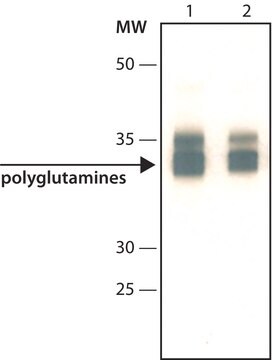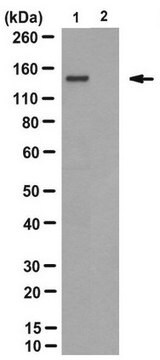MAB5374
Anti-Huntingtin Protein Antibody, clone mEM48
culture supernatant, clone mEM48, Chemicon®
Synonim(y):
Huntingtin
About This Item
Polecane produkty
pochodzenie biologiczne
mouse
Poziom jakości
forma przeciwciała
culture supernatant
rodzaj przeciwciała
primary antibodies
klon
mEM48, monoclonal
reaktywność gatunkowa
human
reaktywność gatunkowa (przewidywana na podstawie homologii)
mouse, rat
producent / nazwa handlowa
Chemicon®
metody
immunocytochemistry: suitable
immunohistochemistry: suitable
western blot: suitable
izotyp
IgG
numer dostępu NCBI
numer dostępu UniProt
docelowa modyfikacja potranslacyjna
unmodified
informacje o genach
human ... HTT(3064) , SLC6A4(6532)
Opis ogólny
Specyficzność
Immunogen
Zastosowanie
1:50-1:100 of a previous lot using ABC on 4% paraformaldehyde fixed tissue. Suggested dilution buffer is PBS containing 3% BSA. The antibody works on paraffin embedded tissue sections.
Suggested dilution buffer is PBS containing 3% BSA. The antibody works on paraffin embedded tissue sections. Yu, Z et al (2002) Hum. Mole. Genetics 11(8):905-914. (http://hmg.oxfordjournals.org/cgi/content/full/11/8/905) for good IHC methods and photos of mEM48 on rodent tissues with human transgenic material.
Immunocytochemistry:
light 4% PFA fixation followed by 0.1% triton X-100 incubation prior to blocking is suggested.
A previous lot of this antibody was used in IC.
Western blot:
1:50-1:500 using ECL depending on the level of mutant protein. Suggested dilution buffer is PBS containing 3% BSA or PBS containing 5% non-fat milk.
Nuclear fraction preparations enhance signals; monomeric protein ~80kDa; aggregates are common which can be >200kDa in size.
Optimal working dilutions must be determined by the end user.
Neuroscience
Neurodegenerative Diseases
Jakość
Western Blot Analysis:
1:1000 dilution of this lot detected Huntingtin Protein on 10 μg of HEK293 lysates.
Opis wartości docelowych
Postać fizyczna
Przechowywanie i stabilność
Handling Recommendations: Upon receipt, and prior to removing the cap, centrifuge the vial and gently mix the solution. Aliquot into microcentrifuge tubes and store at -20°C. Avoid repeated freeze/thaw cycles, which may damage IgG and affect product performance.
Komentarz do analizy
Normal human cerebral cortex lysate, mouse brain cortex samples from HD or wild type mice
HEK293 lysates.
Inne uwagi
Informacje prawne
Oświadczenie o zrzeczeniu się odpowiedzialności
Nie możesz znaleźć właściwego produktu?
Wypróbuj nasz Narzędzie selektora produktów.
polecane
Kod klasy składowania
12 - Non Combustible Liquids
Klasa zagrożenia wodnego (WGK)
WGK 2
Temperatura zapłonu (°F)
Not applicable
Temperatura zapłonu (°C)
Not applicable
Certyfikaty analizy (CoA)
Poszukaj Certyfikaty analizy (CoA), wpisując numer partii/serii produktów. Numery serii i partii można znaleźć na etykiecie produktu po słowach „seria” lub „partia”.
Masz już ten produkt?
Dokumenty związane z niedawno zakupionymi produktami zostały zamieszczone w Bibliotece dokumentów.
Nasz zespół naukowców ma doświadczenie we wszystkich obszarach badań, w tym w naukach przyrodniczych, materiałoznawstwie, syntezie chemicznej, chromatografii, analityce i wielu innych dziedzinach.
Skontaktuj się z zespołem ds. pomocy technicznej






